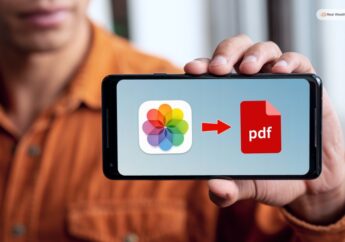Is Online Learning Accessibility Effective? Bringing it to Corporate!
by Ankita Tripathy Technology Published on: 25 May 2022 Last Updated on: 26 November 2024

Continuous professional development at the workplace has proven to be successful in retaining clients and staying competitive in the market. This is made possible with continuous learning even through online learning accessibility.
According to a survey, an average of $1,308 per employee was spent by employers worldwide on L&D.
The world has witnessed a tectonic shift in the primary mode of corporate learning from in-person classroom training to online learning accessibility, actuated by the COVID-19 pandemic in 2020.
As a result, the development of appropriate and accessible online learning accessibility tools has become an important objective of the human resource management sector in organizations.
Online learning accessibility comprises e-learning and m-learning. While e-learning (electronic learning) is defined as the learning enabled by electronic tools and media, m-learning (mobile learning) is e-learning across multiple contexts using mobile devices, wireless transmission, and other electronic devices.
Benefits of Online learning accessibility in Corporate Environments

There are several benefits of using online learning accessibility in place of or in addition to traditional in-person classroom training. These include:
In Brief:
- Global Reach
- Reduction in Cost
- Cascading Learning
- Convenience
- Reduction in Time and Effort
- Increased Productivity
● Global Reach
With companies having their businesses in numerous geographies, in-person classroom training would not match the global reach offered by online learning accessibility.
● Reduction in Cost

Online learning accessibility has enabled organizations to reduce the travel costs of their employees to the respective training locations to a great extent.
● Cascading Learning
Online learning accessibility has also made it easier to train instructors and trainers in a consistent manner.
● Convenience
Digital training is offered through cloud-based platforms. It enables an organization to deliver the training session at the convenience of the instructors and trainers, as well as employees. The training may also be provided in parts vis-à-vis all at once.
● Reduction in Time and Effort
Digital training has enabled employees to acquire and develop new skills and information almost immediately with the help of a cloud-based storage facility.
In contrast to relying on printed matter, which needs to be curated, published, and distributed to all employees, online learning accessibility saves a lot of time and effort for organizations.
● Increased Productivity

Online learning accessibility has enabled employees to choose from a variety of topics according to their personal interests and professional goals, thereby boosting their productivity and efficiency.
Types Of Online learning accessibility Methods

Accessibility plays a vital role in the success of any e-learning module. M-learning (mobile learning) has enabled a multitude of learners to access the e-learning modules at any time, from anywhere, and therefore, managed to gain popularity among the developers of corporate training programs.
Various corporate training programs are designed on the basis of their flexibility and scalability. The various methods of online learning accessibility adopted by various organizations include:
In Brief:
- Web e-learning
- Live online training (virtual classroom)
- Video-based content
- Online assessment
- Microlearning
● Web e-learning
Web e-learning is based on website content. The websites may be accessed by the employees at any time and place from their electronic devices.
The website may include multimedia and other web-based tools, thus enabling the employees to get acquainted with the organization’s communication technology.
● Live online training (virtual classroom)
This model enables the instructors and trainers to connect with the learners virtually from the comfort of their homes.
Being an interactive model, it engages all the participants to collaborate, ideate, and build personal connections, thus adding a human element that is absent in the other methods of online learning accessibility.
● Video-based content

Organizations are increasingly using video modules for the training of their employees. Just like websites, the video modules may be accessed by the employees at any time and place from their electronic devices.
● Online assessment
The online assessment enables the employees to test their knowledge and understanding of the topic learned via an e-learning method.
● Microlearning
Microlearning involves designing e-learning modules in the form of small information nuggets, each addressing one learning objective at a time, taking into consideration the average attention span of a human as not more than 8 minutes.
This method has enabled the employees to retain more information in an efficient manner.
The three digital technologies that can complement the online learning accessibility experience include Learning Experience Platforms (LXPs), Microlearning Platforms, and Learning Analytics Tools.
Online Learning Accessibility

Each employee perceives, interprets, and responds to information in a different manner. Therefore, developing online learning accessibility content may be a waste of time and money, if the employees are unable to absorb the training material that is meant to help them upskill themselves and rise up the corporate ladder.
World Wide Web Consortium (W3C), the main international standards organization for the Internet, published the Web Content Accessibility Guidelines (WCAG).
As recommended by the latest WCAG, the following four principles (also called POUR) shall be the foundation of accessible online learning accessibility content:
In Brief:
- Perceivable
- Operable
- Understandable
- Robust
A. Perceivable
This means that the content and user interface must be available to the learners in ways they can perceive, such as multiple media including visual, text, and audio versions/descriptions.
B. Operable
This means that the user interface and navigation must work with both standard and adaptive input devices.
C. Understandable
This means that the content and training material must be concise, straightforward unambiguous, and in a fitting language (English or others).
D. Robust
This means that the content and training must be manageable through multiple assistive technology and devices. It should also be accessible to learners of various backgrounds and abilities.
Universal Design Of Online learning accessibility Platforms And Its Challenges
Universal Design of an online learning accessibility platform essentially means a course that is designed in a way that fits the needs of all employees, including the differently abled, albeit with assistive technologies.
However, designing such a course requires extensive research, experimentation, coordination, and cooperation.
The two major challenges of universally accessible online learning accessibility platforms are:
- Reduced interactivity of the user interface
In an attempt to cater to ‘all’ employees, the elements of the user interface which engage the learners, often take a back seat. The focus and priority of the developer shift from interactivity to accessibility.
While it is a challenge to prioritize both while designing the online learning accessibility platform, it is not impossible, and if considered from the outset, has a great potential to generate an interface, which is universally accessible and interactive.
- Development of accessible online learning accessibility models/templates
Commercially available applications are not yet capable of catering to the requirement for online learning accessibility platforms to be universally accessible.
This often leads to increased technological glitches, browser incompatibility, and partial accessibility, consequently resulting in an unsatisfactory learning experience and unnecessary cost overruns.
Conclusion
With the world moving towards a digital working environment, it becomes imperative for organizations to equip themselves with the ever-evolving online learning accessibility platforms.
It must be taken into consideration that while e-learning modules have numerous benefits, the benefits may be wholly reaped only via the universal accessibility of such modules.
Online learning accessibility has not only brought the learning resources closer to the masses as long as they have an operational internet connection, but it has also enabled the learners to choose whatever they wish to learn, whenever they wish to learn, and from wherever they wish to learn.
Read Also:



































































































